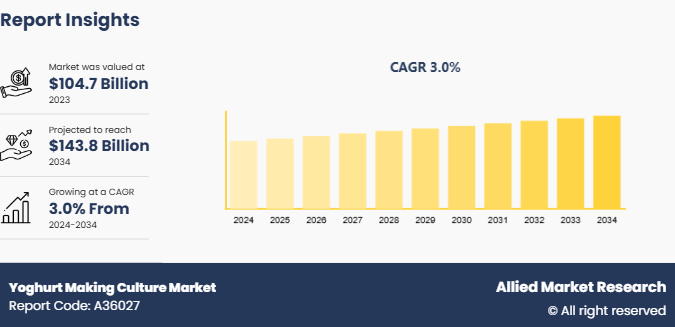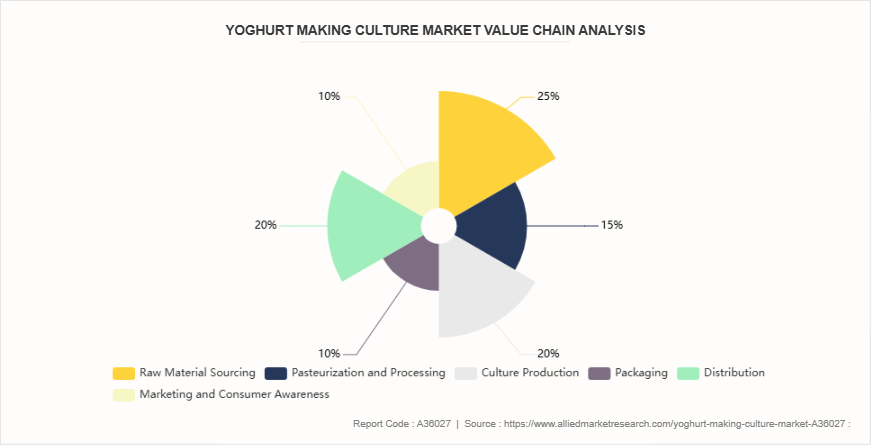Yoghurt Making Culture Market Research, 2034
Market Introduction and Definition
The global yoghurt making culture market size was valued at $104.7 billion in 2023, and is projected to reach $143.8 billion by 2034, growing at a CAGR of 3% from 2024 to 2034. Yoghurt making culture involves specific bacteria that ferment milk, turning natural sugars in the milk into lactic acid. The fermentation process thickens the milk and creates a distinctive tangy taste of yoghurt. The primary bacterial strains used in yoghurt production are Lactobacillus bulgaricus and Streptococcus thermophilus. These bacteria convert lactose into lactic acid, which acts as a preservative and contributes to the creamy texture of yoghurt. The process of making yoghurt starts with heating milk to eliminate unwanted bacteria and then cooling it to an optimal temperature. Starter culture is added to the milk, and the mixture is maintained at around 40-45°C for several hours to ferment. Cooling the yoghurt after fermentation halts further bacterial activity and preserves its quality and taste.

Key Takeaways
The yoghurt making culture market study covers 20 countries. The research includes a segment analysis of each country in terms of value ($Billion) for the projected period 2024-2034.
More than 1, 500 product literatures, industry releases, annual reports, and other such documents of major yoghurt making culture industry participants along with authentic industry journals, trade associations' releases, and government websites have been reviewed for generating high-value industry insights.
The study integrated high-quality data, professional opinions and analysis, and critical independent perspectives. The research approach is intended to provide a balanced view of global markets and to assist stakeholders in making educated decisions in order to achieve their most ambitious growth objectives.
Key Market Dynamics
The rise in consumer preference for probiotic-rich foods has significantly surged market demand for the yoghurt making culture . Probiotics are known for positive impacts on gut health, digestion, and overall immunity, driving consumers to seek food products that deliver such benefits. As a popular source of probiotics, yoghurt has experienced increased consumption as health-conscious individuals prioritize functional foods, thus driving growth of market. Growing awareness of maintaining a balanced diet and the search for natural solutions to digestive issues have contributed to higher demand for probiotic-infused products. Manufacturers have responded by creating yoghurt products that highlight probiotic content, catering to consumers focused on health benefits alongside taste. The surge in preference for probiotic-rich options continues to fuel the expansion of the yoghurt making culture market size, supporting growth across various regions and product segments.
However, challenges in maintaining product shelf life restrain the yoghurt making culture market demand by impacting product quality and consumer confidence. Yoghurt is a perishable product that requires specific storage conditions to preserve its probiotic content and taste. Factors such as temperature fluctuations, improper handling, and microbial contamination can lead to reduced shelf life, which affects both the distribution and retail phases. Short shelf life increases the risk of spoilage and waste, posing difficulties for manufacturers and retailers in maintaining inventory levels and minimizing losses. This issue can result in higher production costs and deter market expansion, especially in regions with limited cold chain infrastructure. Consumers may be discouraged from purchasing products with shorter shelf lives owing to concerns regarding freshness and potential waste. These challenges hinder the growth of the yoghurt making culture market share by limiting market penetration and reducing likeliness to potential buyers and distributors.
The development of innovative flavors and combinations has created numerous opportunities in the market. Consumers seek unique and diverse taste experiences, prompting manufacturers to introduce new products. For instance, in April 2024, Danone North America launched REMIX, a yoghurt range featuring mix-ins such as honey praline almonds, dark chocolate, graham cookies, toasted marshmallow bark, chia granola, and caramel pearls across brands Oikos, Too Good & Co., and Light + Fi to attract health-conscious buyers. In December 2023, Chobani launched Chobani Creations, offering dessert-inspired Greek yoghurt with healthier alternatives like Mocha Tiramisu and Cherry Cheesecake, and gained popularity among various consumer groups. These innovations expand product offerings and drive consumer interest, resulting in increased market demand and growth for the yoghurt making culture industry across different demographics globally.
Value Chain of Global Yoghurt Making Culture Market

The value chain of the yoghurt-making culture market starts with raw material sourcing, including milk, cream, and probiotics. Dairy farms supply these raw materials, ensuring high quality and freshness. The raw materials undergo pasteurization to remove harmful bacteria. Yoghurt making culture, involving bacterial strains like Lactobacillus and Streptococcus, is then added into it. The mixture is then fermented, cooled, and packaged into consumer-friendly containers that preserve freshness and support branding. Packaging is followed by distribution, including retail stores, online platforms, and food service channels. Manufacturers, distributors, and retailers collaborate to ensure widespread availability. Marketing and consumer awareness campaigns drive demand for yogurt, particularly in regions with growing health-conscious populations.
Market Segmentation
The yoghurt making culture market is segmented into type, application, distribution channel, and region. By type, the market is classified into mesophilic culture, thermophilic culture, probiotic culture, and others. By application, the market is divided into commercial and residential. By distribution channel, it is fragmented into supermarkets/hypermarkets, specialty stores, B2B, online sales channel, and others. Region wise, the market is analyzed across North America, Europe, Asia-Pacific, and LAMEA.
Regional/Country Market Outlook
Increase in consumer awareness regarding the health benefits of probiotics, such as improved gut health and immunity, boosts demand for yoghurt in North America during the yoghurt making culture market forecast. The rise of health-conscious consumers seeking functional foods has led to a surge in demand for protein-rich, low-fat, and plant-based yoghurt options. Innovation in flavors and product offerings, such as organic and dairy-free varieties, caters to evolving consumer preferences. The popularity of snacking contributes to the rise of yoghurt as a convenient and nutritious option, thus driving market growth. In addition, the growing availability of yoghurt products in retail stores and online platforms has increased accessibility, supporting yoghurt making culture market expansion. All such factors are driving the continued growth of the yoghurt making culture market share in North America.
Increase in health awareness among consumers is fueling demand for probiotic-rich and functional food products such as yoghurt, which has helped drive growth of yoghurt making culture in Asia-Pacific region. The rise in disposable incomes, particularly in emerging economies, has led to greater consumption of dairy products, including yoghurt. In addition, the growth in popularity of plant-based alternatives, such as coconut and almond milk-based yoghurts, aligns with the shift toward vegan and dairy-free diets. Expanding urbanization and busy lifestyles are increasing the demand for convenient, ready-to-eat snacks, with yoghurt being a popular option. Moreover, innovations in local flavors and regional variations, such as mango or lychee-infused yoghurts, are helping manufacturers cater to diverse consumer preferences. These factors are driving growth and providing vast opportunities for the yoghurt making culture market growth in the Asia-Pacific region.
Industry Trends:
Increase in demand for clean-label products has shaped the global yoghurt making culture market. Consumers have become more selective about ingredients, preferring yoghurts with minimal, natural components and no artificial additives or preservatives. This shift has encouraged manufacturers to create simpler formulations with transparent labeling, focusing on organic, non-GMO, and sustainably sourced ingredients. Companies operating in the market have started incorporation of functional ingredients such as vitamins and minerals, to attract health-conscious buyers who seek more than basic nourishment. Brands such as Siggi’s and Stonyfield Organic are offering clean-label yoghurts that meet the growing consumer preference for healthier, transparent, and wholesome yoghurt options.
Competitive Landscape
The major players operating in the yoghurt making culture market include Chr. Hansen A/S, Danisco A/S (DuPont) , DSM Nutritional Products, Lesaffre Group, Beneo GmbH, Lallemand Inc., Sacco System S.r.l., AB Vista, Bioprox, and Calpis Co. Ltd.
Recent Key Strategies and Developments
In September 2023, DSM-Firmenich launched Delvo Fresh Pioneer, a starter culture line designed for mild yogurt, offering stable pH for up to 60 days in cold storage to improve product shelf life, maintain quality, and reduce acidity over time, catering to creamy, smooth, and reduced-sugar yogurt varieties.
In January 2022, IFF Health & Biosciences introduced 4 new cultures under its Yo-Mix Prime series for yogurt manufacturers to expand their product portfolio with Yo-Mix Prime 801, 802, 830, and 840.
Key Benefits For Stakeholders
- This report provides a quantitative analysis of the market segments, current trends, estimations, and dynamics of the yoghurt making culture market analysis from 2024 to 2034 to identify the prevailing yoghurt making culture market opportunities.
- The market research is offered along with information related to key drivers, restraints, and opportunities.
- Porter's five forces analysis highlights the potency of buyers and suppliers to enable stakeholders make profit-oriented business decisions and strengthen their supplier-buyer network.
- In-depth analysis of the yoghurt making culture market segmentation assists to determine the prevailing market opportunities.
- Major countries in each region are mapped according to their revenue contribution to the global market.
- Market player positioning facilitates benchmarking and provides a clear understanding of the present position of the market players.
- The report includes the analysis of the regional as well as global yoghurt making culture market trends, key players, market segments, application areas, and market growth strategies.
Yoghurt Making Culture Market Report Highlights
| Aspects | Details |
| Market Size By 2034 | USD 143.8 Billion |
| Growth Rate | CAGR of 3% |
| Forecast period | 2024 - 2034 |
| Report Pages | 225 |
| By Type |
|
| By Application |
|
| By Distribution Channel |
|
| By Region |
|
| Key Market Players | Chr. Hansen A/S, Lallemand Inc., LESAFFRE GROUP, Danisco A/S (DuPont), Bioprox, Calpis Co. Ltd., Sacco System S.r.l., BENEO GmbH, DSM nutritional products, AB Vista Ltd. |
Rise in demand for probiotics, plant-based cultures, sustainable practices, functional benefits, innovative flavors, and clean-label yogurts are some of the upcoming trends of Yoghurt Making Culture Market.
The leading application of the yogurt-making culture market is in the production of probiotic-rich yogurt, which is known for its digestive health benefits, nutritional content, and versatile use in various culinary and dietary applications.
By region, North America held the highest market share in terms of revenue in 2023.
The global yoghurt making culture market was valued at $104.7 billion in 2023.
The major players operating in the yoghurt making culture market include Chr. Hansen A/S, Danisco A/S (DuPont), DSM Nutritional Products, Lesaffre Group, Beneo GmbH, Lallemand Inc., Sacco System S.r.l., AB Vista, Bioprox, and Calpis Co. Ltd.
Loading Table Of Content...



